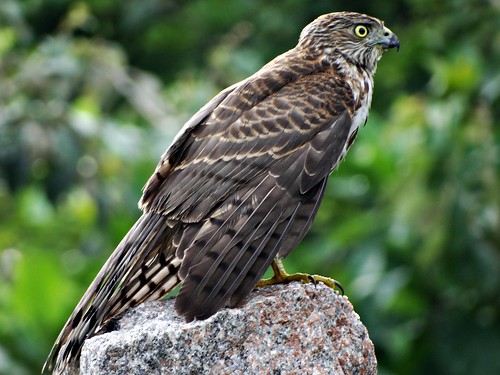 |
| A female Western Marsh Harrier |
By James Gorman, The New York Times, November 14, 2011
The Western marsh
harrier is a typical hawk. It has a sharp beak and talons, which it uses to
kill other creatures for food and to defend its territory. It’s the kind of
bird that exemplifies military virtues, and it’s no wonder that it has a
fighter jet, the British-made Harrier, named after it. Recent science, however,
has discovered another side to the harrier that may not fit as well with the
rather macho military image. Some harriers have evolved an alternative lifestyle
— cross-dressing.
Hawks don’t wear
clothes, of course, or makeup or stiletto heels, so they can’t dress at all,
strictly speaking. But they do depend on appearance, in their case plumage, to
advertise their sex. The males have light gray wings and the females dark
wings. Usually. In one population in western France, however, about 40 percent
of the males have permanent female plumage, according to a report in Biology
Letters, a publication of the Royal Society (that’s British, not
French royalty).
Audrey Sternalski, and her colleagues who
contributed to the report, uncovered the extent of this deception and also
studied the hawk she-males. I didn’t just grab that word from the Internet, by
the way. It came from a paper in Nature on garter snakes published
quite a while ago. The authors referred to snakes, in which female mimicry is
common, as she-males and he-males, so I figure those are scientific terms.
Many different
creatures — particularly fish and reptiles and insects — engage in female
mimicry. Garter snake males may emit chemicals called pheromones to suggest
that they are female, but they do this for only a couple of days after they
emerge from winter dens. Apparently, their goal is to get warm. Garter snakes
form mating balls of 100 males or more around real females. She-males attract
enough males to give them a snake-hug, and once they’ve warmed up, turn off the
pheromones.
Among birds, only
two species are known in which adult males may have permanent female plumage.
The first one to be studied is the ruff, a shorebird that gathers in large
groups during mating season. The ruff she-males sneak around, pretending to be
female, avoiding competition with he-males and stealing kisses, or as
scientists call them, extra-pair copulations. Humans do the same thing, at
least in movies (Tony Curtis, “Some Like It Hot”) and short-lived television
sitcoms featuring future megastars (Tom Hanks, “Bosom Buddies”).
Dr. Sternalski, of
the Institute
for the Study of Hunting Resources in Ciudad Real, Spain, and her
Spanish and French colleagues used decoys to see if the she-male hawks were
attacked by other males as often as the he-males were. As they suspected, the
she-males flew under the he-male radar. They were not attacked or challenged by
the other males. They also behaved like real females, directing their
aggression toward females, not males. One surprise was that when it came to
outside threats they were more actively aggressive than the he-males. When
predators (or predator decoys) threaten the winter roost, Dr. Sternalski said,
the “typical males manipulate the others to defend the roost.” The he-males
recruit the she-males to attack the apparent intruder while they do the hawk
equivalent of sitting on the stoop shouting encouragement: “Look out for the
fox!”
For all this work,
there has to be some payoff for the she-males other than simply avoiding
challenges from other males. The best guess so far is that the she-males are
going for those prized extra-pair copulations, and Dr. Sternalski is testing
that idea now.
Research into bird
behavior does not usually have an immediate effect on society. But hawks have a
long history as military symbols, and I wonder how this news will be greeted by
the folks who wear eagles on their epaulets, and those who give military
aircraft names like Nighthawk, Jayhawk, Hawk and Black Hawk.
The armed forces in
the United States have come around to the idea that men and women,
heterosexuals and homosexuals, can be soldiers, but they are still sticklers
about plumage. Hot pink lipstick is not included in battle gear. Could the
discovery that some of those symbols of bravery and battle toughness are the
bird equivalent of transvestites mean the uniform code will loosen up?
The comedian Eddie
Izzard, who describes himself as an action transvestite — “running, jumping,
climbing trees, putting on makeup while you’re up there” — once described his
crushed childhood ambition to join the army. He suggested that the military
could be more flexible about fashion, and capitalize on the element of surprise
in its attacks. “What,” he asked, “could be more surprising than the First
Battalion Transvestite Brigade?”
Just
a joke, of course, a little poke in the ribs to conventional masculinity, a
suggestion that hot pink lipstick and fabulous lashes don’t mean you can’t
shoot or punch, or attack predators when they come near the nest. There will
never be such a brigade, but if there were, I have an insignia in mind: a
she-male marsh harrier on a field of earth tones with eyeliner in one talon and
lipstick in the other.
No comments:
Post a Comment